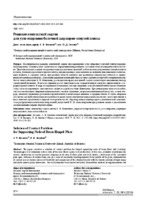| dc.contributor.author | Босаков, С. В. | |
| dc.contributor.author | Скачёк, П. Д. | |
| dc.coverage.spatial | Минск | ru |
| dc.date.accessioned | 2019-08-12T09:15:13Z | |
| dc.date.available | 2019-08-12T09:15:13Z | |
| dc.date.issued | 2019 | |
| dc.identifier.citation | Босаков, С. В. Решение контактной задачи для узла опирания балочной шарнирно опертой плиты = Solution of Contact Problem for Supporting Node of Beam Hinged Plate / С. В. Босаков, П. Д. Скачёк // Наука и техника. – 2019. – № 4. – С. 274-283. | ru |
| dc.identifier.uri | https://rep.bntu.by/handle/data/55888 | |
| dc.description.abstract | Рассматривается решение контактной задачи для шарнирного узла опирания балочной плиты перекрытия (покрытия). Основная цель заключается в определении напряженного состояния области опирания плиты на стену. При этом решаются задачи построения эпюры реактивных давлений в области непосредственного контакта плиты и стены, уточнения расчетного пролета плиты, влияния размера зоны контакта на величину максимального изгибающего момента в середине плиты, определения области контакта при различных показателях гибкости и сравнения полученных результатов с известным решением взаимодействия жесткого штампа и упругой четвертьплоскости. Расчет ведется методом Б. Н. Жемочкина, реализация которого для данной задачи соответствует смешанному методу строительной механики. В качестве примера расчет выполняется на сосредоточенную нагрузку, приложенную в середине пролета плиты. В ходе исследования установлено, что при опирании железобетонной плиты как на бетонную стену, так и на кирпичную зона контакта сводится к двум участкам Жемочкина. При уменьшении показателя гибкости, что соответствует опиранию плиты на менее жесткое основание, возрастает контактная область, что, в свою очередь, влияет на увеличение расчетного пролета плиты и изгибающего момента в середине плиты. В случае опирания абсолютно жесткой плиты (показатель гибкости равен нулю) контактные напряжения достигают своего максимума в месте контакта края плиты и упругой четвертьплоскости. Характер эпюры подтверждается аналитической зависимостью распределения контактных напряжений, полученной В. М. Александровым при решении задачи о вдавливании жесткого штампа в грань упругого клина. | ru |
| dc.language.iso | ru | ru |
| dc.publisher | БНТУ | ru |
| dc.title | Решение контактной задачи для узла опирания балочной шарнирно опертой плиты | ru |
| dc.title.alternative | Solution of Contact Problem for Supporting Node of Beam Hinged Plate | ru |
| dc.type | Article | ru |
| dc.identifier.doi | 10.21122/2227-1031-2019-18-4-274-283 | |
| local.description.annotation | The paper considers a solution of contact problem for hinged supporting node of beam floor slab (coating). The main goal is to determine a stress state of the area where a plate rests on the wall. In this case, a number of problems are solved: construction of reactive pressure diagrams in the area of direct plate and wall contact, clarification of the calculated plate span, influence of contact zone size on a value of maximum bending moment in the middle of the plate, determination of contact area at various indices of flexibility and comparison of the obtained results with the known solution of rigid stamp and elastic quarter-plane interaction. The calculation has been carried out by the Zhemochkin method, its implementation for the given task corresponds to a mixed method of structural mechanics. As an illustration, the calculation has been performed on a concentrated load applied in the middle of the plate span. In the course of the study, it has been established that when a reinforced concrete slab rests on concrete and brick walls, the contact zone reduces itself to two Zhemochkin sections. When a flexibility index is decreased that corresponds to slab support on a less rigid base, the contact area is increased, and that, in its turn, has an influence on an increase of the calculated slab span and the bending moment in the middle of the slab. In the case of an absolutely rigid plate support (flexibility index is equal to zero), the contact stresses reach their maximum value at the point of plate edge contact and elastic quarter-plane. The nature of the diagram is confirmed by an analytical dependence of contact stress distribution obtained by Aleksandrov V. M. when solving a problem of pressing a rigid stamp into an edge of an elastic wedge. | ru |

